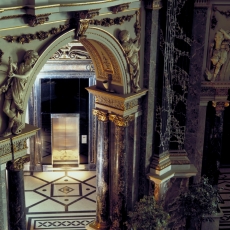
Because of the historical value of the museum as a listed building, the design of the lift car as well as that of the individual lift portals was designated as a separate project, to be carried out in close collaboration with the Federal Office for the Preservation of Historical Monuments. The integration of the individual lift portals into the large, stuccolustro framing around the doors of the original building was a stipulation determined by building measures that had already been carried out. The use of black marble glass as a zone of neutralising material between the existing and the new structures became a mediating surface between the two elements of the portal, which were very different not only as regards their proportions but also in their materials. The reflection of the black marble glass partially 'restored' (at least optically) the original depth of the jamb, which had had to be altered for reasons connected with the construction.
The basic structure of the lift car was already determined, as its maximum height was limited to 2.10 m, due to the constructional constraints of the lift shaft. This spatial constraint, coupled with the fact that the lift had to accommodate 13 persons, led to the decision to use polished plate-glass mirrors on the ceiling and for part of the walls. To reinforce this illusion of space, graphic elements were integrated into the design; these included the pattern derived from the original inlaid floor that had already been developed for the museum café. Here it was used for the floor of the lift, albeit on a different scale.
The specific use of lights positioned at different angles additionally underpins the effect of perceptual provocation.

